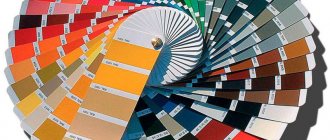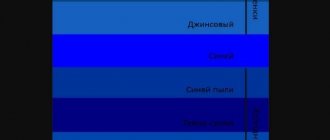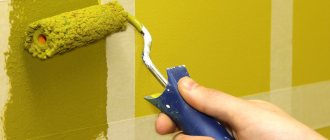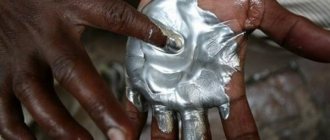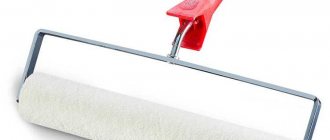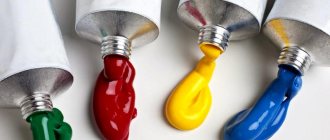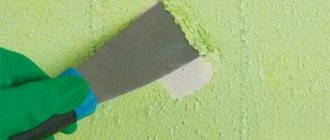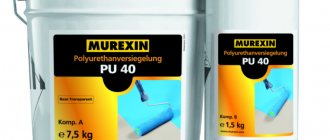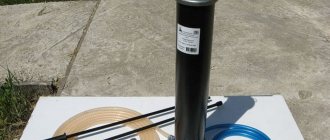Viscosity of paints and varnishes
To better understand how to obtain the desired viscosity, it is necessary to understand the factors that influence this level. The viscosity of paints and varnishes can change under the influence of the following factors:
- Chemical elements used in the composition;
- The amount of solvent introduced into the composition;
- Temperature indicators of the air, the base and the paint and varnish material itself.
The ability of paint to withstand flow largely depends on temperature indicators. When heating occurs to +60-70 degrees, the parameter decreases greatly; an increase in degrees has a slight effect on the material. In order to measure the indicator correctly, the process is carried out under certain conditions.
To improve viscosity, thinners are added. But it is important to administer the product in the correct quantity, otherwise it may disrupt the properties of the composition and lead to complete damage.
To improve viscosity, thinners are added.
Special occasion or acrylic paint
The fact is that acrylic dyes are created on the basis of two-component dyes. If in the case of the same oil or alkyd paint you can add a solvent in the required amount, then you should know how to dilute the paint correctly so as not to spoil the materials.
The first step when working with acrylic is to mix the dye with a special hardener. The proportions must be observed as specified by the manufacturer. A deficiency, as well as an excessive amount of hardener, will negatively affect the characteristics of the coating.
Next, I use a viscometer to check the viscosity and, if necessary, add a solvent. After obtaining a high-quality result in terms of viscosity, the diluted paint can be poured into the paint sprayer and work can begin. The coloring will be of high quality.
There are two ways to measure the required amount of base dye and hardener:
- using special measuring utensils;
- measuring ruler in a cylindrical container suitable for paint.
Measuring rulers are easy to use. The paint is poured into a cylindrical container, then a ruler is lowered there - when the paint level without adding a hardener reaches 40 cm, then to get a ratio of 1:4, it is enough to add a hardener up to 50 cm along the ruler.
Spray guns for acrylic and viscous paints
In industry, special sprayers are used for viscous coatings. The acrylic paint spray gun is an airless spray machine. So, the pump supplies dye under high pressure rather than air into the spray nozzle. But such equipment is expensive.
There is also a more affordable spray gun for acrylic paints - this is an ordinary tool where air is supplied not only to the nozzle, but also to the dye tank. The excess pressure forces the liquid through a special siphon tube.
What depends on viscosity
Why even measure the viscosity level, which depends on the indicator? The influence of the parameter on the tool that will need to apply paint to the surface is highlighted. Whether you use a roller, brushes or a spray gun largely depends on the quality of the paint. Also, the influence of the parameter is significant in the points described below:
- An excessively viscous composition is difficult to distribute over the surface; this will make the layer thicker, and the strength of the result will suffer. The drying of the layer will also slow down;
- A thick consistency will not be able to cover all small flaws, absorb deeper into the base, this will lead to a deterioration in the level of adhesion;
- A thick layer leads to smudges and an unsightly finish;
- Inexpensive spray bottles cannot distribute thick formulations.
The wrong consistency of paint for a spray gun can lead to the need to disassemble it and completely clean it; the remaining part will simply disappear. A composition that is too liquid will not be able to paint the surface efficiently, more layers will have to be made, consumption and work time will increase, and more effort will have to be made.
An excessively viscous composition is difficult to distribute over the surface; this will make the layer thicker, and the strength of the result will suffer.
How to identify quality paint by sight.
Bad paint, diluted with water, will release a light watery liquid on the surface after a couple of days at rest, and after a couple of weeks a lump will form at the bottom of the can.
Good paint, after some time of quiet storage, has a translucent yellowish fatty liquid on the surface (a layer of about 2-5 mm, depending on the size of the can). This is not water, these are necessary additives that are found in every high-quality paint.
If high-quality paint seems too thin to you, but you are used to thick paint, then change the tool and learn how to paint in stages, in several layers. Don't try to thicken the paint, it's not pancake batter! Although, why not - after all, if the pancake batter is thick, the taste becomes bad, but it is easier to fry them. You just need to choose who you are: an eater or a cook.
Thickened paint will form a thick layer with air bubbles and creases. The coating will be loose, fragile, with a large number of defects.
How to measure viscosity
Viscosity determination by Russian manufacturers is carried out in seconds. And foreign brands use the din unit. There is a din table for paint viscosity, which helps to check what level should be for different compositions - acrylic, water-based and others.
Time is recorded and how quickly the paint passes through a special hole is assessed. The faster this happens, the more liquid the composition.
There is a din table for paint viscosity, which helps to check what level different compositions should have.
Measurement Features
The difference in the name of the unit in different countries does not in any way affect the operation of a special device called a viscometer. The parameter is measured over time, the process of flow of the composition takes seconds. And accordingly, the faster it flows through a hole of a certain size, the more liquid the consistency.
The parameter is measured over time, the process of flow of the composition takes seconds.
What does it affect?
The consistency of paints, assessed by viscosity, affects the method of applying them to the surface being treated. The choice of a paint sprayer, brush, or roller is made taking this parameter into account: if you are planning, for example, to buy an XC-010, you should definitely check it. The key principle is that the viscosity of a material is assessed as satisfactory if it does not make it difficult to apply using the chosen method:
- Too fluid, non-viscous varnishes and paints easily flow off surfaces located vertically or at an angle. Because of this, a very thin film remains on the processed product at the top, and sagging forms at the bottom. It will also be more difficult to control the operation of the spray gun.
- Excessively viscous materials complicate the use of paint mixtures, primers and varnishes. They do not pass through the spray gun nozzle or pass with great difficulty. Because of this, the uniform distribution of the paint coating over the surface is disrupted.
Important! For each paint and varnish material there is an optimal viscosity parameter. It determines the method of applying the composition, and also guarantees an even film of equal thickness over the entire surface.
Methods for determining viscosity
As a standard, a special device is used for measurements, which was mentioned earlier, a viscometer. But if it is not available, then the folk method of visual assessment can be used; it does not give the same exact result, but can be quite acceptable.
If a viscometer is not available, then the traditional method of visual assessment can be used.
Determination of viscosity with a viscometer
To use the device, you should learn the rules of how to use a paint viscometer. The process is simple and includes the following steps:
- Water is poured into a special bathtub and equipment, it helps maintain the required temperature at +20 degrees;
- The nozzle on the viscometer closes;
- A special compartment for paint and varnish material is filled with the selected paint up to the point of the hooks;
- It is necessary to install the equipment correctly, for this purpose there are screws on it that allow you to adjust the position, the sharp parts of the hooks must be placed in a barely noticeable position and be on the same plane;
- The compartment with paint is closed, a thermometer is inserted into a special hole, the nozzle is not opened yet, and it is placed near the beaker;
- When the paint and varnish material reaches the desired temperature of +20 degrees, and bubbles appear, the nozzle can be opened and the seconds can begin to be counted; the count ends after the composition has been added to the container at the level of 50.
If work will be carried out with thick types of materials, then a ball type viscometer is used. Its measurement principle involves counting the seconds the balls pass vertically.
If work will be carried out with thick types of materials, then a ball type viscometer is used.
“Folk method” of measuring viscosity (“by eye”)
This technique depends on the experience of the master; professionals can visually understand how well the paint will be distributed over the surface. The paint is stirred using a stick made of wood or metal. Then take out the stick to see how quickly the composition will drain. And evaluate the degree of density.
Craftsmen made a viscometer for paint with their own hands; to do this, you just need to take a syringe and cut it to a size of 10 mm, and also cut off half of the lower end. The product is poured and the drainage time is recorded.
Take out the stick to see how quickly the composition will drain.
Solvent selection
If you dilute the paint with the wrong solvent, you can simply ruin it. As a rule, all manufacturers indicate in the instructions on the can how to use it: how to apply it, whether this paint is suitable for a spray gun, what is its consumption and, most importantly, what can it be diluted with and in what proportion. This information is sometimes unavailable due to the text being erased, paint getting on it, or if the product is imported and there is no translation of the instructions into Russian on the can.
The instructions are not always readable Source m-strana.ru
In such cases, it is necessary to find out the type of paint and its composition, since each requires a certain type of solvent.
Note! Some manufacturers of expensive paints recommend specially created solvents of the same brand, which are also very expensive.
- Acrylic paint is diluted with ordinary filtered or distilled water, as well as special compounds R-12 and R-651.
- Water-based paints, which are an emulsion of dyes in water, are also diluted with purified water or alcohol or ether.
- Alkyd enamel can be brought to the desired consistency with turpentine, white spirit, xylene, and Nefras-S 50/170 solvent.
- Nitro paint for a spray gun can be diluted with white spirit, purified gasoline, xylene, solvent, or special compounds R-645 and R-646.
- Oil paint, consisting of coloring pigments and drying oil, is brought to the required viscosity with the same drying oil, turpentine, and white spirit.
Solvents for paints Source 1000dosok.ru
- Rubber paint will not tolerate any solvents; it is diluted only with water and stirred frequently.
See also: Catalog of companies that specialize in paints and varnishes and related work
Equipment for viscous materials
If the material has a viscous property, then it is usually applied using spray guns. Different types of spray guns are suitable for this purpose. The following options can be distinguished:
- Airless type, in which the pump immediately pushes out the paint without using air. Its efficiency in using paint is high, but the price is also high, so it is often chosen by professionals;
- Pneumatic, which works by creating pressure with air. More affordable type.
If the material has a viscous property, then it is usually applied using spray guns.
What to do if the mixture is too liquid
If your solution has lost its viscosity due to excessive dilution, there are only two ways to return it to its former consistency.
- Add exactly the same, but thicker paint to it. If we are talking about oil, alkyd or nitro enamels, you can try adding alkyd varnish or another binding mixture used in the production of your paint to the solution.
- Let sit for several hours or days, stirring occasionally. Since the solvent tends to evaporate, a certain part of it will come out. It is advisable to increase the evaporation area and install the container in a constantly ventilated place.
Viscosity of water-based paint
The viscosity of water-based paint, if we take into account the Russian unit, should be on average a minimum of 40, maximum of 45 seconds when manual application methods are used. For a spray bottle, the indicator will be different: 20-25 seconds. The viscosity of water-based paint in din has approximately the same values, only the designation changes.
The viscosity of water-based paint should be on average a minimum of 40, maximum of 45 seconds.
What kind of paint can be used for a spray gun?
With this device you can spray any liquid substances. The main thing is that the composition is not too thick and does not clog the nozzle of the device. Today on the shelves of hardware and construction stores you can find many mixtures for painting wood, glass, and metal.
All of them are combined into five groups, from which various derivatives are obtained.
- Alkyd enamel is made from alkyd resin. The material mixes well with other compounds and dries quickly. Used for finishing wooden, metal, concrete surfaces. Can act as an anti-corrosion primer.
- Acrylic paint is based on ester polymers. It is used during construction work and for painting wooden, metal, plasterboard products and surfaces.
- Water-based paint is the most inexpensive and practical finishing material. The basis of the material is polymers mixed with water and coloring pigment.
- Oil paint is a combination of drying oil and pigment. The compositions are highly toxic, however, they stand out in rich, bright colors.
- Nitroenamels are made from nitrocellulose varnish combined with a coloring pigment. Especially often used in metal finishing.
Each composition has its own characteristics and characteristics, the most important of which is the level of viscosity. In order to properly prepare paint for a spray gun, it is advisable to measure the viscosity of the mixture and use solvents to bring this indicator to the desired value.
What values are considered optimal?
Each manufacturer can indicate its own viscosity parameter that will be needed. This value may be written on the product label. Or you can find it on the company’s website. There is a single table with average indicators, it will also help in this matter.
Each manufacturer can indicate its own viscosity parameter that will be needed.
If the paint is diluted to the desired viscosity, it will be easier to obtain a high-quality result. Determining its value is easy and the process does not take much time. It is especially important to consider viscosity when working with a spray gun.
Why thin the paint?
As is known, the diameters of spray gun nozzles can vary significantly and vary from 0.1 to 4 mm. And we don’t yet take into account cartouche pistols, which are also included in this group of tools. Reasoning logically, it becomes clear that an airbrush with a nozzle of 0.1 mm will obviously not be able to actively spit out thick enamel, but will require a mixture of the most liquid consistency. Moreover, if such “colored water” is poured into the tank of a spray gun with a 4 mm nozzle, then during operation it will break it into very large drops, which will begin to form smudges on the surface. Based on this, before figuring out how to dilute paint for a spray gun at home, you should clearly determine what diameter the nozzle is installed on your tool.
